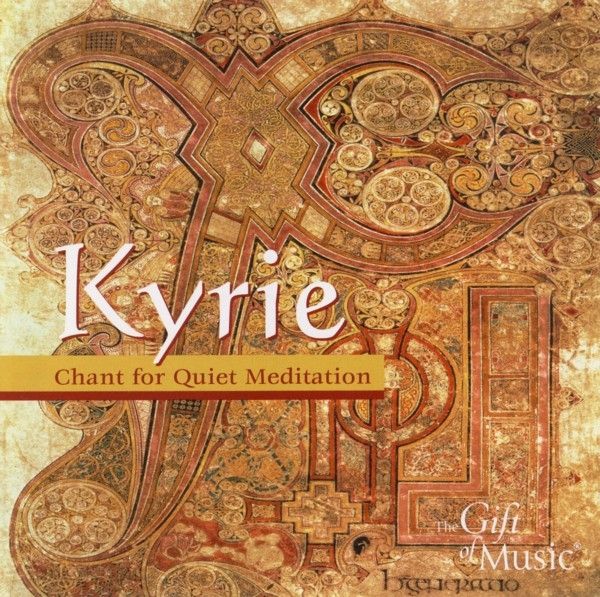
medieval.org
The Gift of Music CCL CDG1180
2008

medieval.org
The Gift of Music CCL CDG1180
2008
Timeless music from the early church, its rites and its rituals,
creates an unhurried atmosphere of calm. Focusing on the Sarum Rite,
vocal plainchant and instrumental music combine in a fine evocation in
sound of the medieval world.
1. Kyrie ‘Cunctipotens genitor Deus’ [6:03] Codex Faenza
2. ‘Studentes’ [1:44]
3. Kyrie ‘Conditor kyrie’ [2:05]
4. Kyrie eleison. Square 1 [2:11]
5. Kyrie ‘Deus creator omnium’ [2:26]
6. Kyrie eleison. Square 2 [1:07]
7. Kyrie eleison. Square 3 [1:28]
8. Kyrie ‘Rex immense’ [1:24]
9. Kyrie eleison. Square 4 [1:29]
10. Kyrie ‘Fons bonitatis’ [3:19]
11. Kyrie eleison ‘Civitate’ [2:01]
12. Kyrie eleison. Square 5 [1:19]
13. Kyrie eleison. Square 6 [1:30]
14. Kyrie ‘Lux et origo’ [1:56]
15. Kyrie ‘Cunctipotens genitor Deus’ [3:22]
Codex Calixtinus
cc 111
16. Kyrie eleison. Square 7 [1:45]
17. Kyrie ‘Omnipotens pater’ [2:15]
18. Kyrie eleison. Square 8 [1:04]
19. Kyrie eleison. Square 9 [1:33]
20. Kyrie eleison. Square 10 [1:23]
21. Kyrie ‘Orbis factor’ [1:54]
22. Kyrie ‘Verbum incarnatum’ [4:06]
Arnold de LANTINS
23. Kyrie eleison. Square 11 [1:32]
24. Kyrie eleison. Square 12 [1:43]
25. Kyrie ‘Cunctipotens genitor Deus’ [2:14]
26. Kyrie [1:44] Codex Las Huelgas
Hu 5
27. Kyrie ‘Rex genitor’ [2:15]
28. Kyrie eleison. Square 13 [1:22]
29. Kyrie ‘Rex Marie’ [2:11]
30. Kyrie eleison. Square 14 [1:06]
31. Kyrie ‘Rex splendens’ [3:13]
32. Kyrie eleison. Square 15 [1:44]
33. ‘Sol sub nube’ [5:56]
The Oxford Clerkes
Alistair Carey
John Duggan
Gregory Skidmore
Jonathan Stainsby
Christopher Watson - soloist
Le Basile
Uri Smilansky, vielle
Marc Lewon, gittern, viola d'arco
Recorded at St. Michaels & All Angels, Summertown, Oxford
on January, 2008
Cover image: MS 58 fol.34r Chi-rho from the Gospel of St.
Matthew, chapter 1 verse 18,
Book of Kells c.800, Irish School
copy, The Board ofTrinity College, Dublin, Ireland/The Bridgeman Art
Library
© 2008 Classical Communications Ltd
www.thegiftoftnusic.com
Classical Communications
Kyrie
Chant for Quiet Meditation
Kyrie eleison · Lord have mercy
Kyrie eleison · Lord have mercy
Kyrie eleison · Lord have mercy
Christe eleison · Christ have mercy
Christe eleison · Christ have mercy
Christe eleison · Christ have mercy
Kyrie eleison · Lord have mercy
Kyrie eleison · Lord have mercy
Kyrie eleison · Lord have mercy
The Greek words of ‘Kyrie eleison’ (‘Lord have
mercy’) have been set to music almost from the moment when they
became an essential part of the Christian liturgy of the Mass or Holy
Communion The symbolic three-fold repetition of the invocation of
‘Lord’ and then of ‘Christ’ and a repeat of the
initial ‘Lord’ produce nine lines in all, and thus quite a
substantial framework upon which to hang a complex musical structure.
In fact the concept of this A-B-A form has underpinned most Western
music for a thousand years.
As ‘Kyrie eleison’ became a familiar and frequently used
text it quickly acquired decoration and elaboration. Just as the
medieval builders decorated the arches and window traceries of their
buildings with ornamentation and theological explanation, so the
musicians and composers developed and ornamented their original texts,
adding words and music which related to specific events in the Church
calendar. The ‘Kyrie eleison’ was used daily in church
services, but it soon came almost always to have these extra words and
thus went from being an ‘Ordinary’ (an every day unchanging
text, like the psalms) to being a ‘Proper’, always
associated with a specific liturgical time such as Advent, Christmas or
Easter.
This recording includes all nine ‘Proper’ Kyries from the
Sarum Rite, a specifically English version of the universal texts and
music of the church which centred around the way things were done in
Salisbury cathedral and elsewhere in Southern England in medieval
times. In addition we have recorded here in their entirety, (we believe
for the first time) a group of Kyrie ‘Squares’. A square is
a single line of music (as is plainchant) but which is thought to have
derived from a pre-existing polyphonic piece. The square is often
developed from the bass line of a four- or five-part motet. The square
is extracted from its original piece and can then be used as a new
single line upon which to base a further new composition. For this
recording we have been content to use improvisations on these melodies
(performed on a selection of instruments by Le Basile) as prefaces to
the melodies themselves in unadorned form, but in medieval and
renaissance times many of these themes were used by composers as the
starting point for very significant and elaborate works.
These two main groups of music are punctuated on the recording by a
further series of ‘Kyries’ which have survived as
instrumental works in a variety of English and Continental manuscripts.